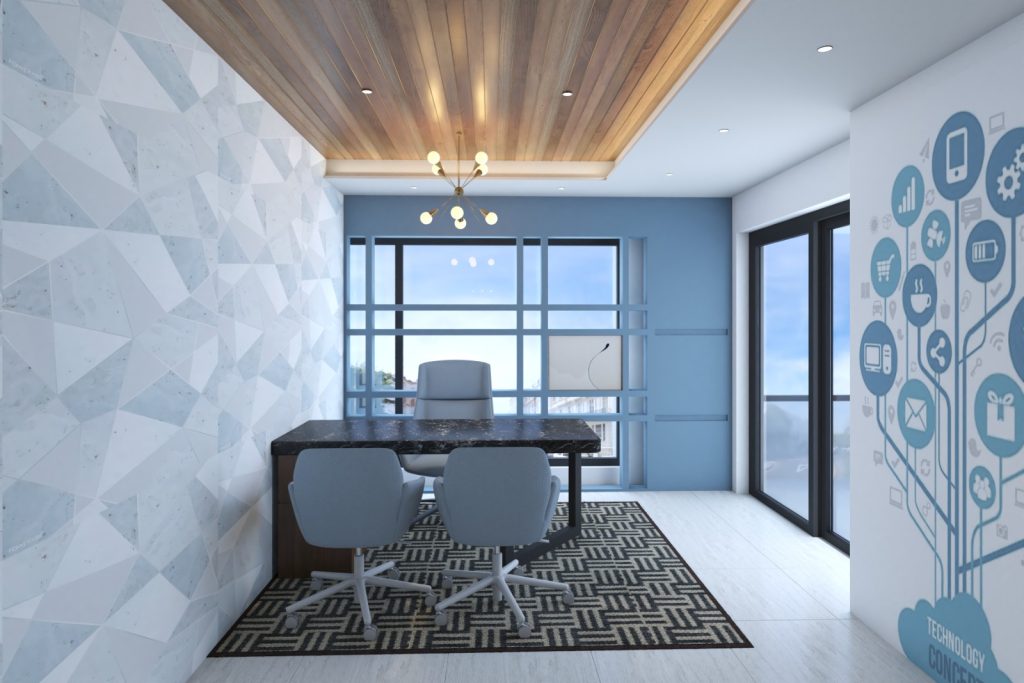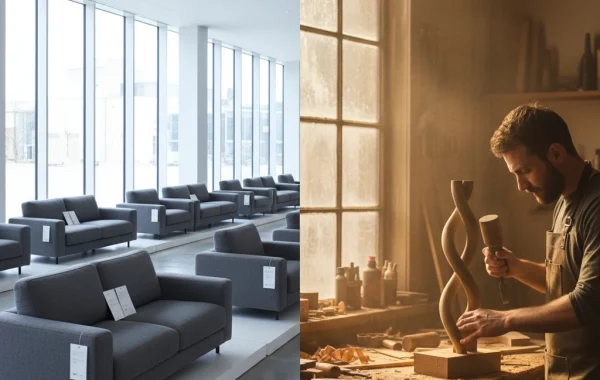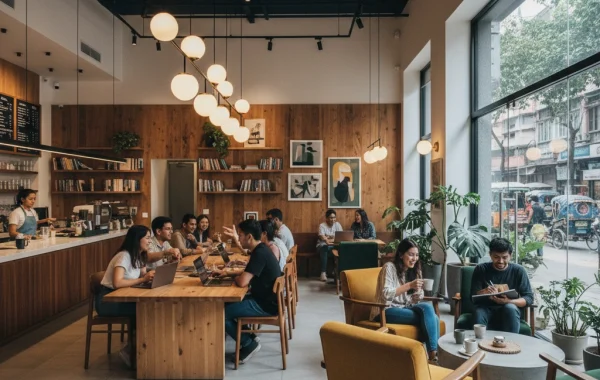The Evolution of the Modern Office Interior
Office Interior Design from In-Art Studio
The traditional office, with its rows of identical cubicles and beige walls, is a relic of the past. Today, a modern office interior is not just a place to complete tasks; it’s a strategic asset designed to foster creativity, collaboration, and employee well-being. This shift reflects a fundamental change in how we view work itself. Companies are now competing for talent not just with salaries but with superior work environments.
A well-designed office can significantly enhance productivity, alleviate stress, and foster a positive company culture. It becomes a destination where people feel inspired and engaged. This article will delve deep into the core principles of modern office design, exploring the key elements that are shaping the workspaces of today and tomorrow. We will examine how a strategic modern office interior can revolutionize your business and its people.
Key Principles of Modern Office Design: A Holistic Approach
The philosophy behind a modern office is holistic. It moves beyond aesthetics to consider the psychological and physical needs of employees. The design is no longer a top-down mandate but a collaborative process that listens to the needs of the people who use the space. A central tenet is flexibility. The modern office is agile, featuring various zones that cater to diverse work styles. This is a significant departure from the one-size-fits-all approach of the past.
The design also prioritizes natural elements, or biophilia, to connect people with nature. This has been shown to improve mental health and reduce absenteeism. Sustainability is another non-negotiable principle. From eco-friendly materials to energy-efficient systems, a modern office is built with the planet in mind. It’s about creating a healthy environment for both the people and the planet. These principles form the foundation of a workspace that is both intelligent and humane.


Activity-Based Working: The Cornerstone of a Modern Office Interior
A hallmark of a modern office interior is the implementation of activity-based working (ABW). This design philosophy recognizes that people perform different tasks throughout the day. It creates various zones optimized for these activities. For example, there are quiet zones with private pods for focused work that requires deep concentration. There are also informal lounge areas with comfortable seating for casual brainstorming and impromptu meetings.
Collaboration areas with large communal tables and whiteboards encourage team interaction and idea sharing. A successful ABW layout also includes breakout areas for employees to relax and recharge. These spaces can be anything from a simple tea and coffee station to a fully-equipped game room. This flexibility empowers employees to choose the environment that best suits their current task. It promotes autonomy and makes the office a more dynamic and engaging place to be. An activity-based office breaks down departmental silos and fosters a more collaborative culture.
The Rise of “Resimercial” Design: Blurring the Lines
The COVID-19 pandemic accelerated the trend of “resimercial” design. This is a blend of residential comfort with commercial functionality. Companies are trying to make the office feel more like a home away from home. This approach incorporates cozy, home-like elements into the office. Think plush sofas, warm lighting, textured rugs, and custom bookshelves. The goal is to create a more relaxed and welcoming atmosphere.
This trend is particularly popular for common areas and collaboration zones. It encourages a sense of comfort and belonging. Employees feel more at ease, which can lead to better communication and creativity. A resimercial design also helps in the transition back to the office from remote work. It makes the office a more desirable place to be. It shows that the company cares about the comfort and well-being of its employees.
The Power of Biophilia: Bringing Nature Indoors
Biophilic design is a critical component of a truly modern office interior. It involves integrating natural elements into the built environment. This can be as simple as adding potted plants and green walls. It can also be as complex as a central atrium with living trees and water features. The benefits of biophilia are well-documented. Exposure to nature has been shown to reduce stress, improve cognitive function, and enhance creativity.
It also improves air quality and helps regulate humidity. We design spaces to maximize natural light, which is essential for our circadian rhythms. Large windows, skylights, and glass partitions are used to flood the office with sunlight. This not only makes the space more pleasant but also reduces the need for artificial lighting. It’s a win-win for both people and the planet. Biophilic design creates a calming and restorative environment that supports employee health and happiness.
The Evolution of the Modern Office Interior has seen a significant shift towards biophilic design in recent years. In-Art Studio focuses on integrating natural elements into office spaces to create a healthier and more productive environment for employees. Modern Office Design trends now include features such as potted plants, green walls, and central atria with living trees and water features. The benefits of biophilia are extensive, ranging from reduced stress levels and improved cognitive function to enhanced creativity and better air quality.
Maximizing natural light through large windows, skylights, and glass partitions not only enhances the aesthetics of the office but also promotes employee well-being and reduces energy consumption. Biophilic design aims to connect employees with nature, fostering a sense of well-being and contentment. Incorporating natural elements into the workplace has become a key aspect of modern office interior design. Strategies such as green walls and indoor plants contribute to a healthier and more inspiring work environment. Additionally, introducing elements like water features and living trees can further enhance the overall ambiance of the office space. By prioritizing biophilic design principles, businesses can create workplaces that prioritize employee wellness and productivity.
Acoustics and Ergonomics: The Unsung Heroes
While aesthetics are important, the most functional aspects of a modern office interior are often invisible. Acoustics is one such element. In an open-plan office, noise can be a major distraction. Poor acoustics can lead to stress, reduced concentration, and communication breakdowns. We use a variety of strategies to manage sound. This includes sound-absorbing materials like acoustic panels, ceiling baffles, and soft furnishings. We also use strategic placement of furniture and zoning to create quieter areas.
Ergonomics is another crucial, yet often overlooked, component. An ergonomically designed office supports the physical health of employees. This includes adjustable sit-stand desks, ergonomic chairs, and monitor stands. A comfortable workspace reduces the risk of musculoskeletal disorders and promotes good posture. It shows a company’s commitment to the long-term health of its employees. A well-designed ergonomic setup can lead to increased productivity and fewer sick days.
Smart Technology Integration: The Office of the Future
A truly modern office interior is one that is intelligently connected. Technology is seamlessly integrated into the design. Smart lighting systems can automatically adjust brightness based on the time of day and occupancy. This saves energy and improves employee comfort. Smart HVAC systems can regulate temperature and air quality. Touchless technology for doors, faucets, and elevators enhances hygiene and convenience.
Meeting rooms are equipped with state-of-the-art video conferencing systems. These systems make it easy for hybrid teams to collaborate effectively. Booking systems for desks and meeting rooms streamline the workday. This level of technological integration makes the office more efficient and user-friendly. It demonstrates a commitment to innovation and future-proofing the workspace.
Branding and Aesthetics: Creating a Unique Identity
A modern office interior is a powerful representation of a company’s brand identity and values. The design should tell a story about the company’s mission and culture. This can be achieved through color palettes, custom graphics, and unique furniture. For example, a tech company might opt for a minimalist, futuristic look. A creative agency might choose a vibrant, eclectic design.
The aesthetics should align with the company’s brand promise. It’s about more than just painting the walls; it’s about creating an emotional connection with the space. The design should also reflect the company’s commitment to its employees. A well-branded office instills a sense of pride and belonging among staff. It also leaves a lasting impression on clients and visitors.
Sustainability: Building a Responsible Modern Office
Sustainability is no longer a trend; it’s an imperative. A modern office interior is designed with a focus on environmental responsibility. This includes the use of recycled or upcycled materials. It also involves choosing furniture from sustainably managed forests. Energy-efficient lighting, such as LED bulbs, and motion sensors are standard features.
We also focus on maximizing natural light to reduce energy consumption. Waste management systems, including recycling and composting, are integrated into the design. A sustainable office has a lower operational cost in the long run. It also appeals to a new generation of employees who are environmentally conscious. It shows that the company is a responsible corporate citizen.
The Future of the Modern Office: A Human-Centric Hub
The future of the modern office interior is a human-centric one. The focus will continue to be on creating environments that support health, happiness, and well-being. Offices will become more flexible, adaptable, and personalized. Technology will play an even greater role in creating seamless and efficient workflows. The lines between work and life will continue to blur, making the office a more inviting and comfortable place. The key is to see the office not as a cost center but as a hub for innovation and human connection. It’s about designing a space where people don’t just work but thrive.
The Evolution of the Modern Office Interior not only aligns with current design trends but also resonates with environmentally conscious employees. It signifies the company’s commitment to being a responsible corporate entity. The future of office design will revolve around creating human-centric spaces that promote health, happiness, and overall well-being. Offices will prioritize flexibility, personalization, and technology integration to enhance productivity and comfort.
Emphasizing a seamless blend of work and life, the modern office will serve as a hub for innovation and human connection, fostering a thriving environment for employees. The shift towards human-centric office design is evident in the integration of wellness features and flexible layout options. Sustainable materials and energy-efficient systems are becoming standard in modern office interiors.
Technology will play a crucial role in enhancing communication and collaboration among employees in the workplace. Personalization and comfort will be prioritized to create a conducive environment for creativity and productivity. The future of office design lies in creating spaces that support the well-being and performance of employees.

Redefining the Workspace Ecosystem
The modern office is evolving to prioritize flexibility, personalization, and seamless technology integration, fostering productivity and well-being. Offices are transforming into hubs for innovation and human connection, emphasizing a harmonious work-life balance. With a focus on wellness, sustainability, and technological advancements, the future of office design aims to create thriving environments that support employee performance and creativity.
As organizations adapt to changing work dynamics, the design of workspaces will continue to focus on flexibility and collaboration. Innovations in technology will further enable remote work and seamless communication among teams. Employee well-being will remain a central theme in office design, promoting health and productivity. By incorporating elements of nature and sustainability, workspaces will aim to create a harmonious and inspiring environment for employees.
The future of office design will strive to enhance employee experiences and foster a sense of belonging and purpose within the workplace. The evolution of office spaces reflects the changing needs of modern workers and organizations, prioritizing flexibility and adaptability. Companies are increasingly integrating technology and sustainable practices into their office designs to enhance efficiency and environmental responsibility.
Collaborative work environments are becoming more prevalent, fostering creativity and teamwork among employees. Wellness initiatives, such as ergonomic furniture and natural light, are being incorporated into office designs to promote employee health and well-being. The future of office design will continue to revolve around creating spaces that inspire innovation, productivity, and a sense of community among employees.
Modern Office Design: Shaping the Future of Office Interiors
In today’s fast-paced corporate world, office interior solutions are no longer just about aesthetics. They’re about creating functional, innovative, and people-centric environments. Modern office design is reshaping how we view the workplace by blending flexibility, smart technology, and wellness-focused elements. Businesses are now investing in interiors that support different work styles, from quiet zones for focused tasks to open spaces that encourage collaboration.
The emphasis on biophilic design, ergonomic furniture, and eco-friendly materials not only enhances productivity but also boosts employee morale. Natural lighting, green plants, and sustainable resources are becoming essential features in modern interiors. These thoughtful design choices help reduce stress and promote a healthier work environment.
As hybrid work continues to grow, office interiors must adapt with modular layouts, tech-integrated meeting spaces, and comfortable breakout zones. The result is a workspace that feels more human, encouraging creativity, engagement, and a stronger sense of purpose. In short, modern office design plays a crucial role in transforming offices into vibrant ecosystems where people thrive, collaborate, and innovate.
Redefining Office Interiors for the Modern Era
The concept of office interior has evolved far beyond four walls and a desk. In today’s dynamic business world, interior design plays a vital role in shaping how employees interact, perform, and feel in their workplace. With the rise of hybrid work models and remote collaborations, office spaces are being reimagined to serve both functional and emotional needs. The focus is no longer just on productivity—it’s about creating a space where people genuinely want to be. Companies are now investing in interiors that reflect their brand values while offering an environment that nurtures wellness and innovation.
Offices today are more human-centered, putting the well-being and comfort of employees at the core of every design decision. Whether it’s incorporating cozy lounges, quiet zones, or creative brainstorming areas, interior designers are using psychology and spatial planning to promote a sense of purpose and belonging. The future of office design is undoubtedly driven by experience rather than routine.
Modern Office Design: A Blend of Functionality and Flexibility
Modern office design emphasizes flexibility, modularity, and seamless tech integration. The one-size-fits-all layout is no longer relevant. Instead, offices are moving toward multipurpose layouts where spaces can be rearranged according to tasks or team needs. From adjustable workstations to mobile dividers and plug-and-play conference rooms, every element is crafted to support collaboration and creativity.
Technology also plays a vital role in this transformation. Touchless entry systems, smart lighting, noise-canceling pods, and high-speed connectivity are now integral parts of office infrastructure. These features ensure smooth communication, both onsite and remotely, making the workspace more inclusive and adaptable.
Nature, Wellness & Sustainability in Office Interiors
Biophilic design the inclusion of natural elements like indoor plants, wood textures, and daylight is becoming a core aspect of office interiors. It not only enhances visual appeal but also supports mental health and stress reduction. Offices are being designed with natural ventilation, acoustic panels, and ergonomic furniture to improve focus and reduce fatigue.
Sustainability is no longer a trend but a standard. Eco-friendly materials, energy-efficient systems, and waste reduction strategies are actively being implemented. This shift toward green design is not only good for the planet but also strengthens a company’s brand image and appeal to conscious consumers and employees.
Inspiring Innovation Through Design
Ultimately, great office interior design fosters innovation, connection, and purpose. As workplaces evolve, so must their environments. Modern office interiors are becoming ecosystems supporting not just work, but well-being, collaboration, and growth.



